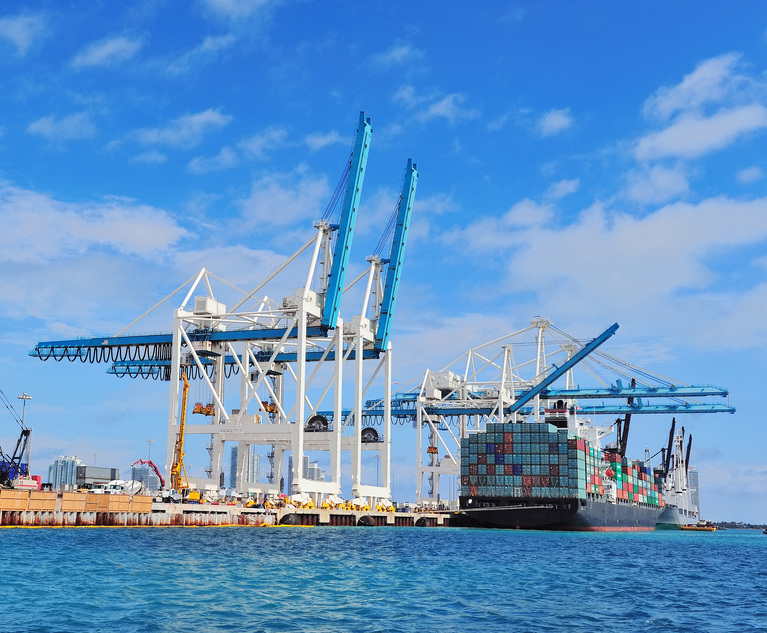 Cargo ship at Miami Port. Credit: rabbit75_fot/Adobe Stock
Cargo ship at Miami Port. Credit: rabbit75_fot/Adobe Stock Florida Ports Get Cargo Traffic Boost, See Cruise Rebound
The annual Seaport Mission Plan, issued by the Florida Ports Council, said the state's ports handled 112.5 million tons of cargo last year, up 6% from 2021 and 0.5% higher than in 2019, the last full year before the COVID-19 pandemic.
February 23, 2023 at 11:13 AM
3 minute read
Global supply-chain issues last year helped push cargo traffic at Florida's 16 seaports slightly ahead of pre-pandemic numbers, while the cruise industry is expected to return to pre-pandemic passenger counts this year.
The annual Seaport Mission Plan, issued Wednesday by the Florida Ports Council, said the state's ports handled 112.5 million tons of cargo last year, up 6% from 2021 and 0.5% higher than in 2019, the last full year before the COVID-19 pandemic.
Meanwhile, the cruise industry in Florida recorded 10.8 million passengers in 2022, 41% fewer than in 2019, according to the council report.
Michael Rubin, president and CEO of the ports council, said the cruise industry is trending this year toward the 2019 totals. Florida's cruise industry handles about 60% of all U.S. passenger traffic and plays a vital role in the state's tourism industry.
"The parking decks are full. I've got [Port] Canaveral and [Port] Everglades and [Port] Miami trying to rent out areas off port to park people," Rubin said. "I think we'll beat [2019] this year. People have been sitting at home and going, 'Hell, I gotta get back out.'"
Rubin, also the administrator of the Florida Seaport Transportation and Economic Development Council, said the increase in cargo last year stemmed from shipping companies looking to avoid slowdowns at the California ports of Los Angeles and Long Beach while carrying cargo from Asia and South America.
"I think the supply-chain crisis and our ability to react to it was probably the No. 1 thing," Rubin said.
"We're always trying to peel away those things that are coming over to this side [of the U.S.]," Rubin added. "We're getting more from the Europe side and certainly more is coming through the Suez [Canal] from Asia."
Rubin said Gov. Ron DeSantis helped highlight Florida's ports as supply-chain backups drew international attention and as shipping firms sought different ports to unload cargo.
"It used to be that you had a significant deficit on the East Coast versus the West Coast, on consumer products coming in," Rubin said. "And it's actually a little bit more on the East Coast of the United States now. And I don't see that reversing."
Florida, like the rest of the U.S., is also benefiting from an increase in trade with Mexico.
With Mexico as the United States' top trading partner in terms of value, exports to Mexico were up 30.7% from 2020 to 2021, and imports from Mexico grew by 18.3% in the same time, according to the latest figures from the U.S. Department of Commerce's Bureau of Industry and Security.
DeSantis last month proposed a budget for the 2023-24 fiscal year that would provide $150.5 million for ports, up from $135.9 million in the current fiscal year. Lawmakers will consider the proposal during the legislative session that will start March 7.
The newly released ports report listed $2.3 billion in priority projects to expand port capacity.
The projects ranged from $981 million for cruise-terminal developments at Port Miami and $100 million for dredging, turning-basin expansion and other improvements at Port Tampa Bay to $3.5 million for the Maritime High-Performance Center of Excellence Dock Complex at the Port of Pensacola and $505,000 for infrastructure development at the newly designated Port Putnam.
Jim Turner reports for the News Service of Florida.
NOT FOR REPRINT
© 2025 ALM Global, LLC, All Rights Reserved. Request academic re-use from www.copyright.com. All other uses, submit a request to [email protected]. For more information visit Asset & Logo Licensing.
You Might Like
View All

U.S. Eleventh Circuit Remands Helms-Burton Trafficking Case Involving Confiscated Cuban Port
3 minute read
Blank Rome Adds 4 From Akerman in Second 2024 White Collar Group Hire
4 minute read
Goods-Trade Deficit Narrows to Smallest in Nearly 2 Years
Trending Stories
- 1Midlevel Appellate Court Reinstates New York's Voting Rights Act
- 2Consumer Protection Suit Cleared to Go Forward Against Irritating Eye Serum
- 3COVID-19 Was Still Relevant in Securities Class Actions During 2024, Report Says
- 4After Botched Landing of United Airlines Boeing 767, Unlikely Plaintiff Sues Carrier
- 5DOT Moves to Roll Back Emissions Rules, Eliminate DEI Programs
Who Got The Work
J. Brugh Lower of Gibbons has entered an appearance for industrial equipment supplier Devco Corporation in a pending trademark infringement lawsuit. The suit, accusing the defendant of selling knock-off Graco products, was filed Dec. 18 in New Jersey District Court by Rivkin Radler on behalf of Graco Inc. and Graco Minnesota. The case, assigned to U.S. District Judge Zahid N. Quraishi, is 3:24-cv-11294, Graco Inc. et al v. Devco Corporation.
Who Got The Work
Rebecca Maller-Stein and Kent A. Yalowitz of Arnold & Porter Kaye Scholer have entered their appearances for Hanaco Venture Capital and its executives, Lior Prosor and David Frankel, in a pending securities lawsuit. The action, filed on Dec. 24 in New York Southern District Court by Zell, Aron & Co. on behalf of Goldeneye Advisors, accuses the defendants of negligently and fraudulently managing the plaintiff's $1 million investment. The case, assigned to U.S. District Judge Vernon S. Broderick, is 1:24-cv-09918, Goldeneye Advisors, LLC v. Hanaco Venture Capital, Ltd. et al.
Who Got The Work
Attorneys from A&O Shearman has stepped in as defense counsel for Toronto-Dominion Bank and other defendants in a pending securities class action. The suit, filed Dec. 11 in New York Southern District Court by Bleichmar Fonti & Auld, accuses the defendants of concealing the bank's 'pervasive' deficiencies in regards to its compliance with the Bank Secrecy Act and the quality of its anti-money laundering controls. The case, assigned to U.S. District Judge Arun Subramanian, is 1:24-cv-09445, Gonzalez v. The Toronto-Dominion Bank et al.
Who Got The Work
Crown Castle International, a Pennsylvania company providing shared communications infrastructure, has turned to Luke D. Wolf of Gordon Rees Scully Mansukhani to fend off a pending breach-of-contract lawsuit. The court action, filed Nov. 25 in Michigan Eastern District Court by Hooper Hathaway PC on behalf of The Town Residences LLC, accuses Crown Castle of failing to transfer approximately $30,000 in utility payments from T-Mobile in breach of a roof-top lease and assignment agreement. The case, assigned to U.S. District Judge Susan K. Declercq, is 2:24-cv-13131, The Town Residences LLC v. T-Mobile US, Inc. et al.
Who Got The Work
Wilfred P. Coronato and Daniel M. Schwartz of McCarter & English have stepped in as defense counsel to Electrolux Home Products Inc. in a pending product liability lawsuit. The court action, filed Nov. 26 in New York Eastern District Court by Poulos Lopiccolo PC and Nagel Rice LLP on behalf of David Stern, alleges that the defendant's refrigerators’ drawers and shelving repeatedly break and fall apart within months after purchase. The case, assigned to U.S. District Judge Joan M. Azrack, is 2:24-cv-08204, Stern v. Electrolux Home Products, Inc.
Featured Firms
Law Offices of Gary Martin Hays & Associates, P.C.
(470) 294-1674
Law Offices of Mark E. Salomone
(857) 444-6468
Smith & Hassler
(713) 739-1250






